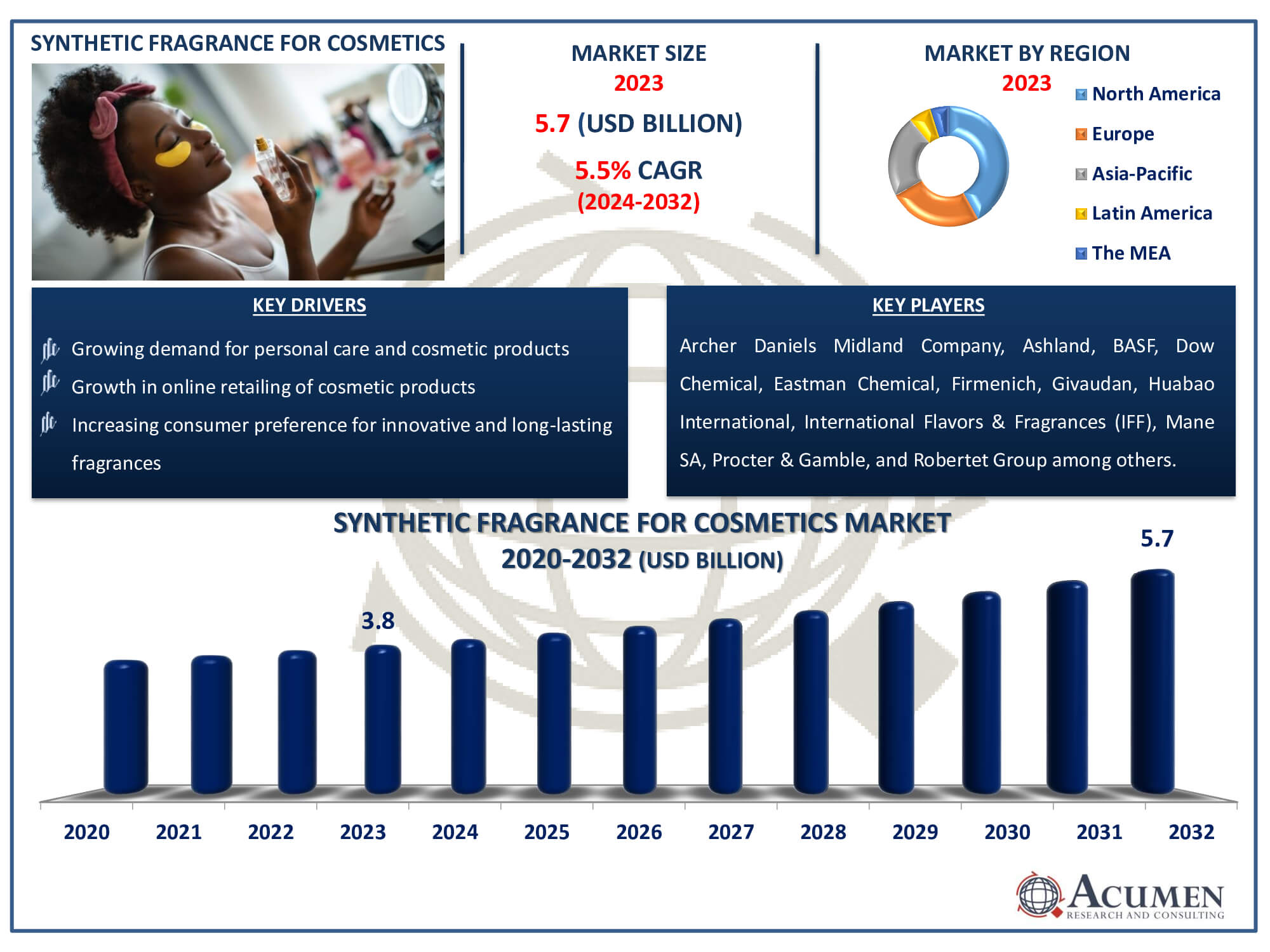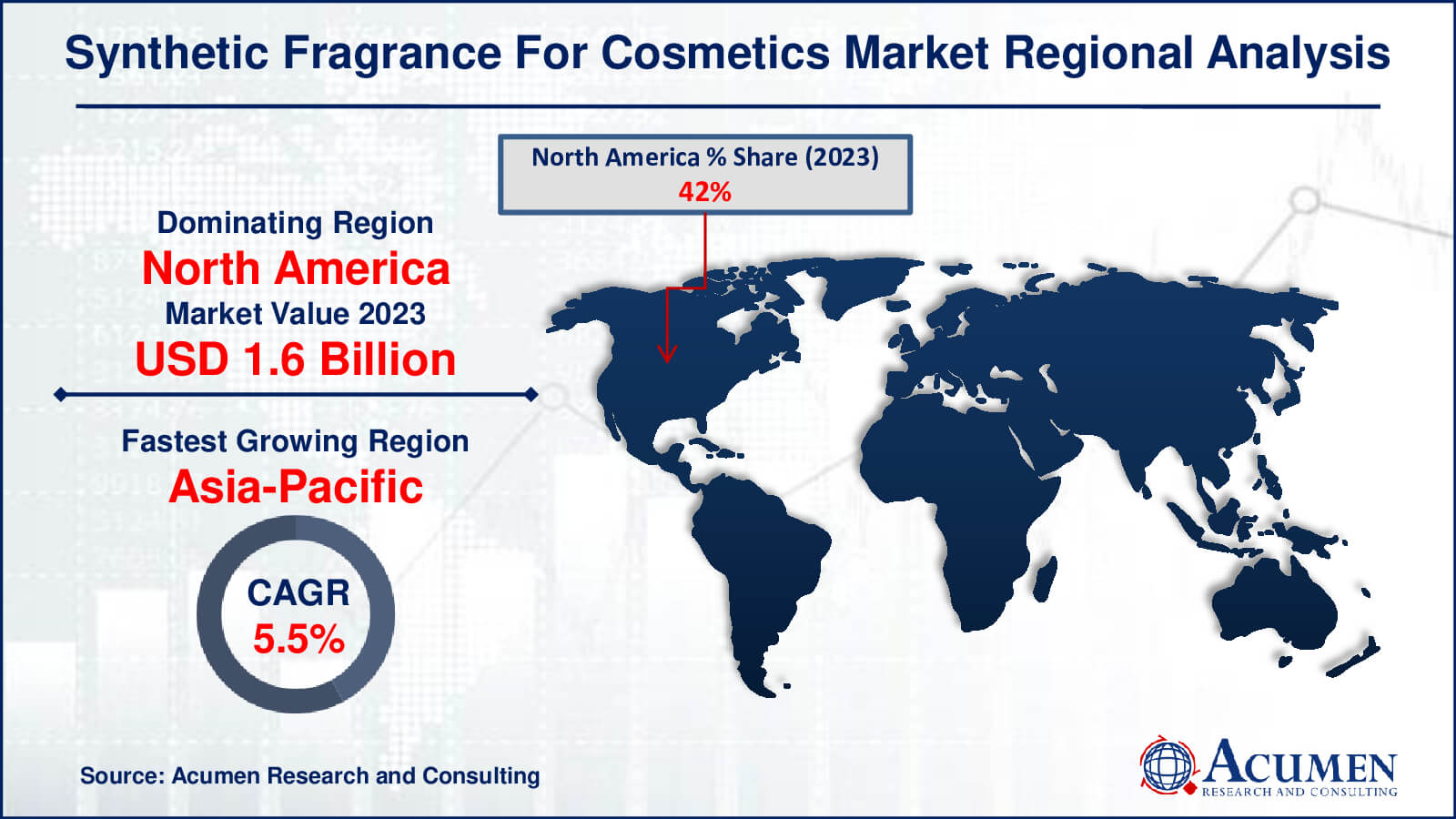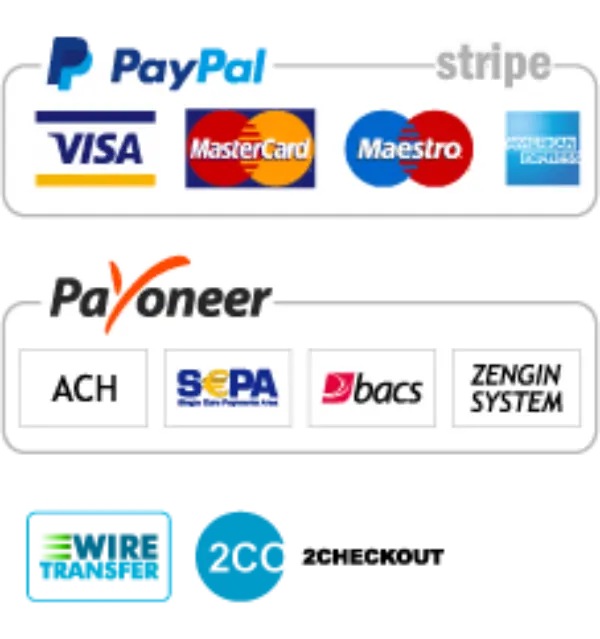Synthetic Fragrance for Cosmetics Market Size - Global Industry, Share, Analysis, Trends and Forecast 2024 - 2032
Published :
Report ID:
Pages :
Format :
Synthetic Fragrance for Cosmetics Market Size - Global Industry, Share, Analysis, Trends and Forecast 2024 - 2032
Report Coverage
- Industry Dynamics
- Market Size and Forecast Data
- Segment Analysis
- Competitive Landscape
- Regional Analysis with a Niche Focus on Country-Level Data
- High Level Analysis - Porter's, PESTEL, Value Chain, etc.
- Company Profiles of Key Players
- Option to Customize the Report As Per Your Specific Need
Request Sample Report
The Synthetic Fragrance for Cosmetics Market Size accounted for USD 3.8 Billion in 2023 and is estimated to achieve a market size of USD 5.7 Billion by 2032 growing at a CAGR of 4.7% from 2024 to 2032.
Synthetic Fragrance for Cosmetics Market Highlights
- Global synthetic fragrance for cosmetics market revenue is poised to garner USD 5.7 billion by 2032 with a CAGR of 4.7% from 2024 to 2032
- North America synthetic fragrance for cosmetics market value occupied around USD 1.6 billion in 2023
- Asia-Pacific synthetic fragrance for cosmetics market growth will record a CAGR of 6.8% from 2024 to 2032
- Among type, the aromatic synthetic fragrance sub-segment gathered significant revenue in 2023
- Based on application, the skin care products sub-segment occupied noteworthy market share in 2023
- increasing adoption of eco-friendly and sustainable synthetic fragrances to meet consumer demand for environmentally conscious products is a popular synthetic fragrance for cosmetics market trend that fuels the industry demand

Synthetic fragrances for cosmetics are artificial scents that are intended to emulate natural aromas or create new fragrances not found in nature. These scents are made up of chemical components that are frequently manufactured in a laboratory to produce a consistent and replicable scent character. Unlike natural smells generated from essential oils or botanical extracts, synthetic perfumes provide more stability, duration, and variety, allowing cosmetic makers to create a diverse spectrum of odors tailored to specific goods and brand identities.
Synthetic scents are widely utilized in the cosmetics sector to improve consumers' sensory experiences in items such as perfumes, lotions, shampoos, and makeup. These scents are popular because they are less expensive, more widely available, and can retain a consistent scent despite variances in natural component supply. However, there is rising awareness and worry about the potential skin irritations and health risks linked with some synthetic fragrance compounds, driving the industry to look into safer, more ecologically friendly alternatives.
Global Synthetic Fragrance for Cosmetics Market Dynamics
Market Drivers
- Growing demand for personal care and cosmetic products
- Growth in online retailing of cosmetic products
- Increasing consumer preference for innovative and long-lasting fragrances
Market Restraints
- Growing awareness regarding the potential health impacts of synthetic fragrances
- Stringent regulations and standards for synthetic fragrance ingredients
- Competition from natural and organic fragrance products
Market Opportunities
- Innovation in fragrance formulation and delivery systems
- Expansion in emerging markets with growing disposable income
- Increasing demand for customized and personalized fragrance products
Synthetic Fragrance for Cosmetics Market Report Coverage
| Market | Synthetic Fragrance for Cosmetics Market |
| Synthetic Fragrance for Cosmetics Market Size 2022 | USD 3.8 Billion |
| Synthetic Fragrance for Cosmetics Market Forecast 2032 | USD 5.7 Billion |
| Synthetic Fragrance for Cosmetics Market CAGR During 2023 - 2032 | 4.7% |
| Synthetic Fragrance for Cosmetics Market Analysis Period | 2020 - 2032 |
| Synthetic Fragrance for Cosmetics Market Base Year |
2022 |
| Synthetic Fragrance for Cosmetics Market Forecast Data | 2023 - 2032 |
| Segments Covered | By Type, By Application, By Distribution Channel, And By Geography |
| Regional Scope | North America, Europe, Asia Pacific, Latin America, and Middle East & Africa |
| Key Companies Profiled | Archer Daniels Midland Company, Ashland, BASF, Dow Chemical, Eastman Chemical, Firmenich, Givaudan, Huabao International, International Flavors & Fragrances (IFF), Mane SA, Procter & Gamble, Robertet Group, Solvay S.A., Symrise, T. Hasegawa, Takasago International Corporation, Lucta, and LANXESS. |
| Report Coverage |
Market Trends, Drivers, Restraints, Competitive Analysis, Player Profiling, Covid-19 Analysis, Regulation Analysis |
Synthetic Fragrance for Cosmetics Market Insights
Several main aspects drive the growth and development of the synthetic fragrance market in cosmetics. One of the key factors is growing customer demand for personal care and cosmetic products with distinctive and long-lasting scents. Synthetic perfumes offer a diverse selection of aroma characteristics that can be consistently reproduced, making them ideal for businesses seeking to create unique and memorable product experiences. Furthermore, synthetic scents are more cost-effective and stable than natural alternatives, assuring a regular supply and quality, which is essential for large-scale production.
However, the market confronts substantial obstacles. Growing consumer concern about the potential health dangers of certain synthetic compounds has resulted in increased scrutiny and regulatory pressure. Many synthetic perfumes include phthalates and other substances that are thought to be endocrine disruptors or allergies. This has spurred regulatory organizations to tighten standards for the use of such drugs, thereby increasing the cost of compliance for manufacturers. As a result, there is a push to create safer, hypoallergenic, and environmentally friendly synthetic smells.
Advances in scent chemistry and biotechnology are opening up new opportunities in the synthetic fragrance sector. Green chemistry and renewable resource-based synthetic scent production are gaining popularity. Companies are investing in R&D to develop sustainable and biodegradable scent compounds that suit consumer demand for environmentally friendly products. This transition to sustainability is being driven not only by customer demand, but also by corporate social responsibility efforts and governmental regulations aimed at decreasing the environmental effect of chemical production.
Synthetic Fragrance for Cosmetics Market Segmentation
The worldwide market for synthetic fragrance for cosmetics is split based on type, application, distribution channel, and geography.
Synthetic Fragrance for Cosmetics Market By Type
- Hydrocarbon Synthetic Fragrance
- Alcohol Synthetic Fragrance
- Aromatic Synthetic Fragrance
- Ether Synthetic Fragrance
- Others
According to the synthetic fragrance for cosmetics industry analysis, aromatic synthetic fragrances currently dominate the synthetic fragrance market for cosmetics. Their widespread use is attributed to their long-lasting scent properties and their versatility in various cosmetic products, such as perfumes, lotions, and personal care items. This preference is driven by consumer demand for unique and consistent fragrances that enhance the sensory experience of cosmetic products.
Synthetic Fragrance for Cosmetics Market By Application
- Skin Care Products
- Moisturizers
- Lotions
- Creams
- Serums
- Hair Care Products
- Shampoos
- Conditioners
- Hair Oils
- Makeup
- Foundations
- Powders
- Lipsticks
- Eye Shadows
- Fragrances/Perfumes
- Bath & Shower Products
- Soaps
- Body Washes
- Others (Deodorants and Antiperspirants)
In recent years, skincare products have dominated the synthetic fragrance industry for cosmetics. Moisturizers, lotions, creams, and serums are consistently in high demand as consumers focus more on personal care and skincare routines. Skincare products frequently require perfumes to improve the user experience, resulting in high usage of synthetic fragrances in this market. Furthermore, the increasing popularity of multifunctional skincare products that offer both skincare advantages and attractive smells contributes to this application's market domination.
Synthetic Fragrance for Cosmetics Market By Distribution Channel
- Online
- E-commerce Websites
- Brand Websites
- Offline
- Supermarkets/Hypermarkets
- Specialty Stores
- Departmental Stores
- Drugstores/Pharmacies
As per the synthetic fragrance for cosmetics market forecast, internet distribution channels will have significant dominance from 2024 to 2032. E-commerce and brand websites have grown in popularity due to their convenience, diverse product offerings, and increasing consumer preference for online buying. The opportunity to compare products, read reviews, and has handy delivery options have all contributed to this increase. While offline channels such as supermarkets, specialty stores, department stores, and drugstores/pharmacies continue to play an important role, the transition to online platforms reflects a trend toward digital ease and accessibility when acquiring synthetic scents for cosmetics.
Synthetic Fragrance for Cosmetics Market Regional Outlook
North America
- U.S.
- Canada
Europe
- U.K.
- Germany
- France
- Spain
- Rest of Europe
Asia-Pacific
- India
- Japan
- China
- Australia
- South Korea
- Rest of Asia-Pacific
Latin America
- Brazil
- Mexico
- Rest of Latin America
The Middle East & Africa
- South Africa
- GCC Countries
- Rest of the Middle East & Africa (ME&A)

Synthetic Fragrance for Cosmetics Market Regional Analysis
In North America, the industry is fueled by strong consumer demand for novel cosmetic items and high spending power. The presence of established brands, as well as the influence of beauty trends, both help to drive market growth. Europe follows a similar trend, with rigorous laws favoring safe cosmetic components and a strong preference for premium and niche scents. The region also shows a growing desire for eco-friendly and natural scent alternatives, which influences market trends.
Rapid urbanization, rising disposable incomes, and changing lifestyles are driving market growth in Asia Pacific. Countries such as China, Japan, and South Korea are major contributors, owing to a thriving cosmetics industry and shifting consumer tastes toward worldwide scent trends. Furthermore, the Middle East and Africa area has significant growth potential, driven by an increasing beauty-conscious population and improving retail infrastructure. Overall, regional variations in consumer behavior, legal frameworks, and economic considerations create the synthetic fragrance market landscape, impacting demand patterns as well as market strategies.
Synthetic Fragrance for Cosmetics Market Players
Some of the top synthetic fragrance for cosmetics companies offered in our report include Archer Daniels Midland Company, Ashland, BASF, Dow Chemical, Eastman Chemical, Firmenich, Givaudan, Huabao International, International Flavors & Fragrances (IFF), Mane SA, Procter & Gamble, Robertet Group, Solvay S.A., Symrise, T. Hasegawa, Takasago International Corporation, Lucta, and LANXESS.
Frequently Asked Questions
How big is the synthetic fragrance for cosmetics market?
The synthetic fragrance for cosmetics market size was valued at USD 3.8 billion in 2023.
What is the CAGR of the global synthetic fragrance for cosmetics market from 2024 to 2032?
The CAGR of synthetic fragrance for cosmetics industry is 4.7% during the analysis period of 2024 to 2032.
Which are the key players in the synthetic fragrance for cosmetics market?
The key players operating in the global market are including Archer Daniels Midland Company, Ashland, BASF, Dow Chemical, Eastman Chemical, Firmenich, Givaudan, Huabao International, International Flavors & Fragrances (IFF), Mane SA, Procter & Gamble, Robertet Group, Solvay S.A., Symrise, T. Hasegawa, Takasago International Corporation, Lucta, and LANXESS.
Which region dominated the global synthetic fragrance for cosmetics market share?
North America held the dominating position in synthetic fragrance for cosmetics industry during the analysis period of 2024 to 2032.
Which region registered fastest CAGR from 2024 to 2032?
Asia-Pacific region exhibited fastest growing CAGR for market of synthetic fragrance for cosmetics during the analysis period of 2024 to 2032.
What are the current trends and dynamics in the global synthetic fragrance for cosmetics industry?
The current trends and dynamics in the synthetic fragrance for cosmetics industries include growing demand for personal care and cosmetic products, increasing consumer preference for innovative and long-lasting fragrances, and growth in online retailing of cosmetic products.
Which type held the maximum share in 2023?
The aromatic synthetic fragrances held the maximum share of the synthetic fragrance for cosmetics industry.


